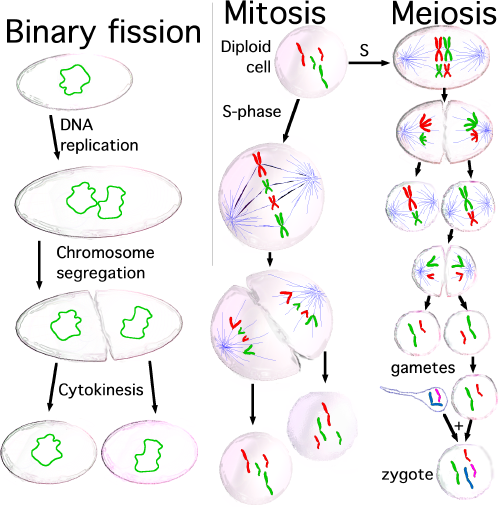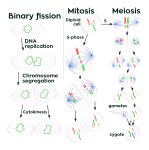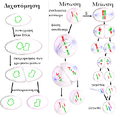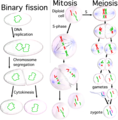File:Three cell growth types.png
Three_cell_growth_types.png (499 × 507 pixels, file size: 170 KB, MIME type: image/png)
| This is a file from the Wikimedia Commons. The description on its description page there is shown below.
|
|

|
File:Three cell growth types.svg is a vector version of this file. It should be used in place of this PNG file when not inferior.
File:Three cell growth types.png → File:Three cell growth types.svg
For more information, see Help:SVG.
|
Three types of cell reproduction are compared: the relatively simple Binary fission and two more complicated types that either involve mitosis or meiosis.
Binary fission. Organisms such as bacteria typically have a single chromosome (green). At the start of the binary fission process, the DNA molecule of the cell's chromosome is replicated, producing two copies of the chromosome. A key aspect of bacterial cell reproduction is making sure that each daughter cell gets a copy of the chromosome. Cytokinesis is the actual physical separation of the two new daughter cells.
Cell reproduction that involves mitosis. Most eukaryotic organisms like humans have more than one chromosome. In order to make sure that a copy of each chromosome gets segregated into each daughter cell, the spindle apparatus is used (blue threads). The chromosomes are moved along the long thin microtubules like trains moving along train tracks. Humans are diploid; we have two copies of each type of chromosome, one from the father (red) and one from the mother (green).
Cell reproduction that involves meiosis. The human sex cells (gametes) are produced by meiosis. For sperm production there are two cytokinesis steps that produce a total of four cells, each with half the normal number of chromosomes. The situation is different in the ovaries for egg production where one of the four sets of chromosomes that is segregated is placed in a large egg cell, ready to be combined with the DNA from a sperm cell (see meiosis for details).
This image was created for the cell growth article.
Source: I made this diagram with ClarisDraw and PhotoShop.
Note: a GFDL license for use of this image was automatically granted when I uploaded the image to Wikipedia. Since User:Bevo requested an explicit copyright status statement and since the Wikipedia:Image description page article suggests that "Adding explicit copyright information helps", I am providing one:
- The copyright to this image is retained by John Schmidt (JWSchmidt).
The Wikipedia:Image description page also suggests including an explicit statement about the GFDL license, so:
- Permission is granted to copy, distribute and/or modify this image under the terms of the Wikipedia GFDL, as indicated in the fine print at the bottom of this page. JWSchmidt 15:11, 11 Apr 2004 (UTC)
Source: English Wikipedia, original upload see file history

|
Permission is granted to copy, distribute and/or modify this document under the terms of the GNU Free Documentation License, Version 1.2 or any later version published by the Free Software Foundation; with no Invariant Sections, no Front-Cover Texts, and no Back-Cover Texts. A copy of the license is included in the section entitled GNU Free Documentation License.http://www.gnu.org/copyleft/fdl.htmlGFDLGNU Free Documentation Licensetruetrue |
| This file is licensed under the Creative Commons Attribution-Share Alike 3.0 Unported license. | ||
| ||
| This licensing tag was added to this file as part of the GFDL licensing update.http://creativecommons.org/licenses/by-sa/3.0/CC BY-SA 3.0Creative Commons Attribution-Share Alike 3.0truetrue |
File history English Wikipedia
(del) (cur) 21:51, 6 July 2004 . . Guanaco (174122 bytes) (transparency, crop, optimize) (del) (rev) 05:21, 31 March 2004 . . JWSchmidt (176449 bytes) (del) (rev) 04:21, 31 March 2004 . . JWSchmidt (176121 bytes) (del) (rev) 03:54, 31 March 2004 . . JWSchmidt (172333 bytes) (Three types of cell growth are compared.)
derivative works
[edit]
SVG:
-
English
-
Kurdish
-
Macedonian
-
Russian
-
Slovenian
PNG:
-
Greek
-
English
-
Slovenian
-
Turkish
Captions
Items portrayed in this file
depicts
File history
Click on a date/time to view the file as it appeared at that time.
| Date/Time | Dimensions | User | Comment | |
|---|---|---|---|---|
| current | 13:36, 16 September 2005 | 499 × 507 (170 KB) | Saperaud~commonswiki | Three types of cell reproduction are compared: the relatively simple Binary fission and two more complicated types that either involve mitosis or meiosis. '''Binary fission'''. Organisms such as bacteria typically have a s |
File usage
The following 2 pages use this file:
Metadata
This file contains additional information, probably added from the digital camera or scanner used to create or digitize it.
If the file has been modified from its original state, some details may not fully reflect the modified file.
| Horizontal resolution | 28.35 dpc |
|---|---|
| Vertical resolution | 28.35 dpc |
| File change date and time | 19:30, 6 July 2004 |










